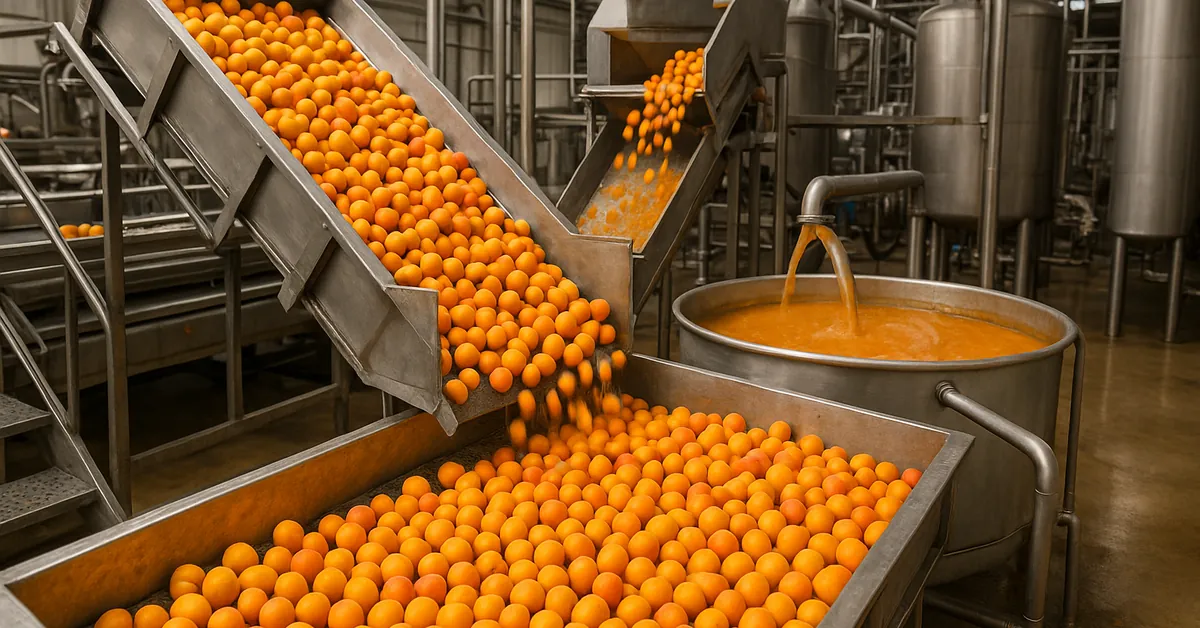In this article you’ll read about:
- What Apricot Juice Concentrate is and how it’s produced
- Quality standards and test parameters
- Adulteration checks and authenticity control
- Packaging, transport & storage
- Industrial applications
- Pricing factors & sustainable supply
- How to choose a supplier
- Why Tomexa
- Frequently Asked Questions (FAQs)
- External standards link (Codex)
Apricot Juice Concentrate is a core ingredient for apricot‐flavoured beverages and foods across global markets. By removing most of the water and standardising the Brix, the concentrate enables economical transport, precise formulation, and consistent flavour across batches. In this comprehensive 2025 guide, we cover the production process, quality standards, packaging, pricing drivers, and bulk-buying tips from reliable suppliers like Tomexa—so you get accurate, up-to-date, and SEO-friendly information.
What is Apricot Juice Concentrate and how is it produced?
Apricot juice concentrate is obtained by washing and sorting ripe apricots, crushing and pressing to extract juice, clarifying (enzyme treatment + filtration) or leaving with controlled pulp depending on the target spec, adjusting acidity, and then evaporating under vacuum to reach the target Brix—typically ~70°Brix for apricot. The product is then pasteurised and packed either aseptically (ambient-stable) or frozen.
Tight control of temperature and residence time during evaporation and pasteurisation protects natural apricot notes and minimises non-enzymatic browning. Trace re-addition of natural aroma (from captured volatiles) can be used in blending to restore a fresh apricot profile without artificial flavours.
Quality standards for Apricot Juice Concentrate
- Brix (°Brix): Concentration of soluble solids; common specs for AJC are 68–72°Brix, most frequently 70°Brix.
- Brix/Acid ratio (B/A): Sensory balance; for apricot (where malic acid predominates) typical B/A is 20–30, depending on cultivar and end use (nectar vs. confectionery).
- Titratable Acidity (TA as malic acid): Set per destination standard; suppliers report TA as % malic acid.
- Colour and turbidity: Desired colour is golden-orange to amber with low haze for clarified grades; pulpy grades will show controlled turbidity.
- Aroma profile: Fresh, clean apricot without fermented or cooked off-notes; no kernel (excessive benzaldehyde/almond) note.
- Microbiology: Must comply with aseptic/frozen requirements (low total plate count, absence of coliforms, yeasts and molds within limits).
- Contaminants & purity: No added sugars/syrups, no artificial colours. Advanced analytics (isotopic ratio, carbon profile, marker compounds) are used to verify authenticity.
Adulteration and authenticity checks
Adulteration risks include dilution, added sweeteners, or blending with cheaper concentrates (e.g., apple/pear/peach) to mimic apricot. To mitigate:
- Request a Certificate of Analysis (COA) per batch plus third-party lab results for authenticity.
- Verify compliance with Codex and destination regulations (external resource below).
- Track Brix/Acid and sensory profile across consecutive shipments; large swings may indicate blending.
- Use isotope and marker tests where claim sensitivity is high (e.g., “no added sugar,” “100% apricot”).
Packaging, transport, and storage
- Packaging: Aseptic 220-265-270 kg drums with multilayer liners, cubic aseptic totes, or IBC; frozen grades supplied in frozen drums.
- Transport: Ocean freight in reefers for frozen AJC; standard containers for aseptic.
- Storage: Aseptic at 0–5 °C (short term) or <0 °C (medium term); frozen at ≤−18 °C.
- Shelf life: Typically 12–24 months, depending on cold chain integrity and dissolved oxygen. De-aeration and controlled headspace help maintain colour and flavour.
Industrial applications
- Nectars & RTD beverages: Reconstituted to consumer Brix for apricot nectar; blends well with apple/peach bases for layered profiles.
- Dairy & ice cream: Stable apricot notes in yogurt, kefir, and frozen desserts; good synergy with vanilla and cream bases.
- Bakery, jams & fillings: High-Brix AJC provides strong flavour and good gel behaviour in jams/jellies and laminated pastry fillings.
- Confectionery & syrups: Clean-label sweetness and fruit identity without artificial flavours.
- Baby foods & purées (where permitted): Natural apricot taste with strict micro limits and contaminant controls.
- Origin & harvest: Major producing regions include Turkey, Iran, Uzbekistan, Spain. Frost or drought during bloom can significantly affect availability and pricing.
- Industrial availability: Evaporation and clarification capacity, plus global inventory levels, move spot prices.
- Logistics & FX: Freight rates (especially reefers), currency swings, and duties shape CIF/FOB outcomes.
- Custom specs: Target Brix, B/A, clarified vs. pulpy, colour grade, and aroma retention all influence cost.
- Quality systems: Suppliers certified to HACCP/ISO 22000 with full traceability lower compliance risk and hidden costs.
How to choose a suitable supplier
- Laboratory transparency: COA per batch, specification sheets, and access to third-party authenticity testing.
- Sensory alignment: Triangle tests and descriptive profiling to match your brand’s target flavour.
- Reliable supply: Phased deliveries, MOQ clarity, buffer stocks, and flexible storage options.
- Technical support: Ability to tailor blends (e.g., colour/Brix/TA adjustments, aroma retention).
- True price competitiveness: Optimise TCO—consider yield, wastage, consumer claims, complaint/return rates, and not just price per kg.
Why Tomexa?
With a multi-stage production and inspection network, Tomexa supplies Apricot Juice Concentrate to your bespoke specs (Brix, B/A, clarified or pulpy). Beyond quality approvals, we offer multiple packaging formats, R&D support for flavour optimisation, and assistance with ordering, international shipping, and customs clearance.
FAQs about Apricot Juice Concentrate
1) What Brix is typical for AJC in beverages?
Most industrial specs target ~70°Brix; for nectars/RTDs it’s diluted to the consumer Brix per destination standard.
2) Can flavour be customised?
Yes. Through blending different origins, adjusting B/A, and managing aroma capture/re-addition, we can tailor fresh apricot notes for your market.
3) Aseptic or Frozen—what should I choose?
Aseptic is common for cost-efficient long routes; frozen is preferred where premium sensory outcomes or longer storage buffers are required.
External link (dofollow)
For recognised juice and nectar standards, consult Codex:
Codex Standard for Fruit Juices and Nectars (CODEX STAN 247-2005)
https://www.fao.org/gsfaonline/standards/detail/en/?code=CXS%20247-2005
For more information and purchasing, please visit our website tomexa.com



